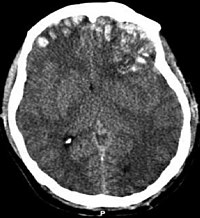
Photo from wikipedia
PurposeDespite the enormity of the problem and the lack of new therapies, research in the pre-clinical arena specifically using pediatric traumatic brain injury (TBI) models is limited. In this review,… Click to show full abstract
PurposeDespite the enormity of the problem and the lack of new therapies, research in the pre-clinical arena specifically using pediatric traumatic brain injury (TBI) models is limited. In this review, some of the key models addressing both the age spectrum of pediatric TBI and its unique injury mechanisms will be highlighted. Four topics will be addressed, namely, (1) unique facets of the developing brain important to TBI model development, (2) a description of some of the most commonly used pre-clinical models of severe pediatric TBI including work in both rodents and large animals, (3) a description of the pediatric models of mild TBI and repetitive mild TBI that are relatively new, and finally (4) a discussion of challenges, gaps, and potential future directions to further advance work in pediatric TBI models.MethodsThis narrative review on the topic of pediatric TBI models was based on review of PUBMED/Medline along with a synthesis of information on key factors in pre-clinical and clinical developmental brain injury that influence TBI modeling.ResultsIn the contemporary literature, six types of models have been used in rats including weight drop, fluid percussion injury (FPI), impact acceleration, controlled cortical impact (CCI), mechanical shaking, and closed head modifications of CCI. In mice, studies are largely restricted to CCI. In large animals, FPI and rotational injury have been used in piglets and shake injury has also been used in lambs. Most of the studies have been in severe injury models, although more recently, studies have begun to explore mild and repetitive mild injuries to study concussion.ConclusionsGiven the emerging importance of TBI in infants and children, the morbidity and mortality that is produced, along with its purported link to the development of chronic neurodegenerative diseases, studies in these models merit greater systematic investigations along with consortium-type approaches and long-term follow-up to translate new therapies to the bedside.
Journal Title: Child's Nervous System
Year Published: 2017
Link to full text (if available)
Share on Social Media: Sign Up to like & get
recommendations!